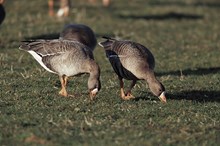09 October, 2015
Hunters urged to id geese in Caithness carefully
With geese beginning to return to Caithness from their breeding grounds, Scottish Natural Heritage (SNH) is urging those shooting wildfowl to make sure they can recognise legal quarry species, even in poor light and difficult weather conditions. Some parts of Caithness are home to Greenland white-fronted geese, a protected species which can't legally be shot in Scotland.
The geese are protected because of their rapid decline since 1999; the world population has dropped from 36,000 to 20,000. They breed in west Greenland and migrate through Iceland to winter in Scotland and Ireland .
Caithness supports two important populations – one in the area around the Westfield/Broubster area and the other around Loch of Mey/Loch Heilen. The geese usually feed in isolated groups favouring low intensity pasture, wet grassland and mires, but they can occasionally be found in mixed flocks with pink-footed and greylag geese, two species which are legal quarry in Scotland in season.
Ian Sargent, SNH Caithness area officer, commented:
“Some wildfowlers who come to Caithness to shoot may not know that there are white-fronted geese here, so it’s important that landowners who lease shooting to visitors pass this information on. Most wildfowlers know the legislation and carry out their sport in a safe and responsible manner. But there have been reports of Greenland white-fronted geese being shot illegally. So we advise shooters that if they’re in doubt, don’t shoot.
“We recommend that shooting parties use a local goose guide, especially for visitors who are unfamiliar with the area and may have difficulty in identifying legal quarry.”
Shooting white-fronted geese in Scotland is a wildlife crime and any incidents should be reported to the police.
Inspector Mike Middlehurst , Police Scotland Wildlife Crime Officer for Highlands and Islands division, said :
“Police Scotland fully supports this preventative and informative step by our partners in SNH . It is also prudent to remind wildfowlers of the legislation regarding the use of lead shot over wetlands and that they comply with the Codes of Good Shooting Practice circulated by various shooting organisations. Over the coming season wildlife officers will be visiting to popular wildfowling areas in the North to educate and advise wildfowlers.”
How to identify white-fronted geese
Greenland white-fronted geese are among the darkest of Scotland’s wild geese. The adults are highly distinctive because they are the only geese that have a white patch around the base of the bill and black stripes, dashes and dots on their bellies, which in some individuals can appear almost completely black. These belly stripes are very conspicuous on the geese in flight.
However, the juveniles, which fly within flocks with their adult parents, have uniformly-coloured bellies which make them look more like the other species. For this reason, one should never shoot at individual geese lacking belly bars within a flock of white-fronted geese.
As well, the feet and legs of Greenland white-fronted geese are bright orange (unlike the pink of greylag and pink-footed geese) and they are smaller, more dainty and are more agile in flight than either of the other two species. The flight call, a high pitch “kyow-yow” is also much higher pitched and very different from that of the greylag or pink-footed goose.
Greylag geese are much larger than white-fronted geese, have a far deeper honking contact call and have conspicuously pale grey forewings. Pink-footed geese are slightly smaller that greylags, with darker heads and short pink and black bills.
ENDS
Media queries: For more information, contact SNH press & public relations officer for Scottish Natural Heritage, Vicki Mowat on 0131 316 2659 or vicki.mowat@snh.gov.uk (Tues-Fri), or the main SNH press office on 01463 725 022.
Contact information
- Name
- SNH Media
- snhmedia@snh.gov.uk
NatureScot is Scotland's nature agency. We work to enhance our natural environment in Scotland and inspire everyone to care more about it. Our priority is a nature-rich future for Scotland and an effective response to the climate emergency. For more information, visit our website at www.nature.scot or follow us on X at https://x.com/NatureScot
’S e NatureScot buidheann nàdair na h-Alba. Bidh sinn a’ neartachadh àrainneachd na h-Alba agus a’ brosnachadh dhaoine gu barrachd suim a chur ann an nàdar. Tha e mar phrìomhachas againn gum bi nàdar na h-Alba beairteach agus gun dèilig sinn gu h-èifeachdach le èiginn na gnàth-shìde. Tha an tuilleadh fiosrachaidh aig www.nature.scot no air X aig https://x.com/NatureScot

